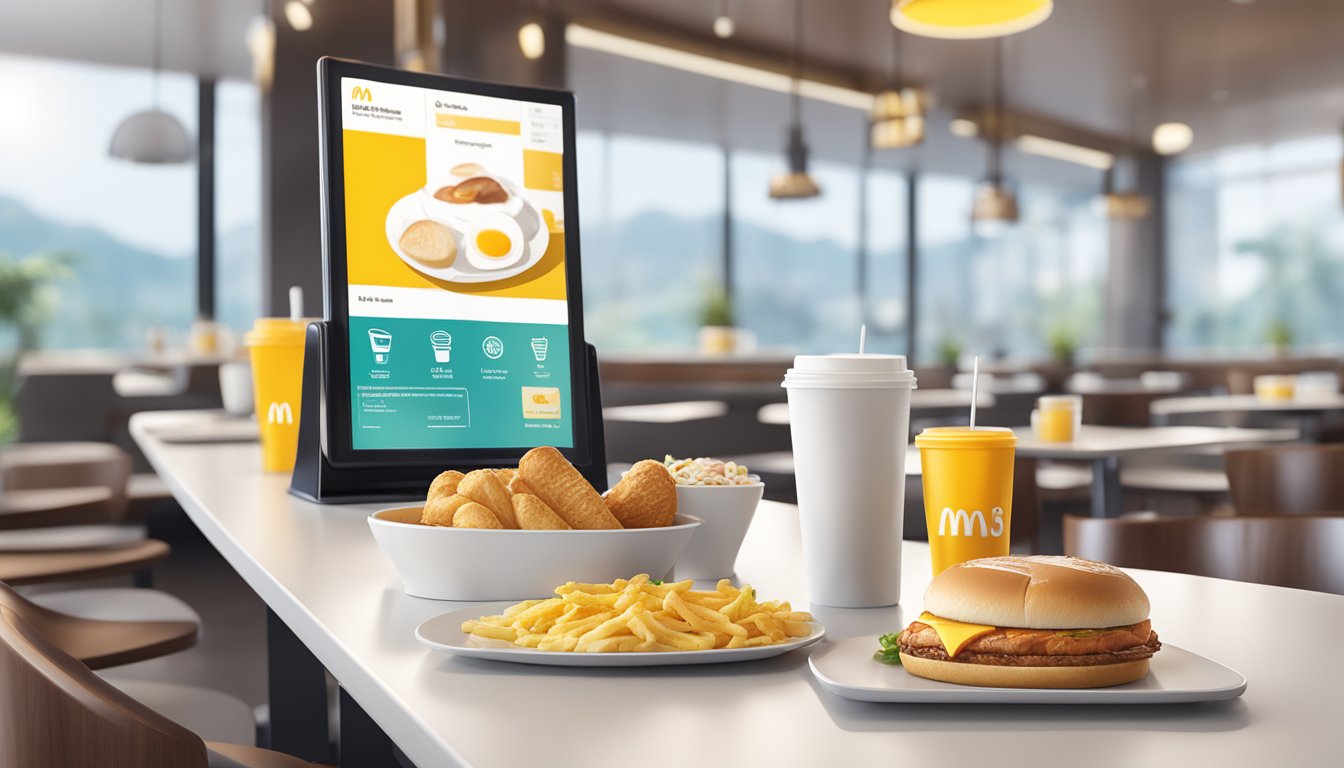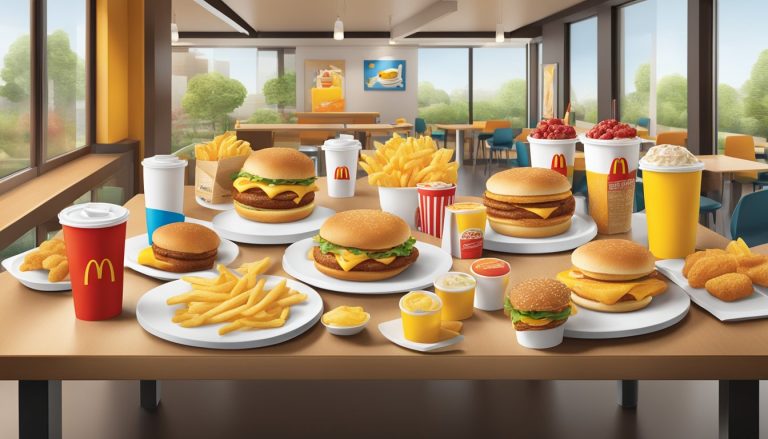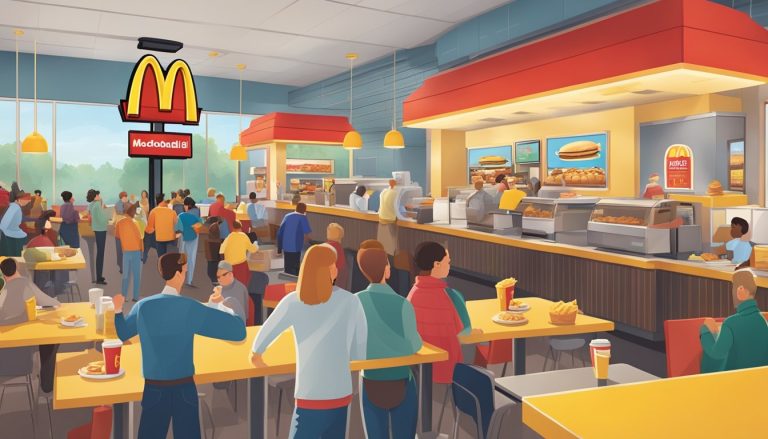McDonald’s revolutionized the fast-food industry when it introduced its breakfast menu in 1972. The Egg McMuffin, created by franchisee Herb Peterson, became the cornerstone of this morning offering. This move transformed McDonald’s from a lunch and dinner destination into an all-day dining option, setting a new standard for fast-food restaurants.
The introduction of breakfast items sparked changes in restaurant design and operations. Kitchen layouts were modified to accommodate new equipment for preparing eggs and toasting muffins. Dining areas were updated to create a more inviting atmosphere for early morning customers. These adaptations influenced the overall aesthetic of McDonald’s locations, blending efficiency with comfort.
As McDonald’s breakfast menu expanded, so did its impact on the fast-food landscape. Competitors rushed to develop their own morning offerings, leading to the “breakfast wars” that continue to shape the industry today. The success of McDonald’s breakfast menu demonstrates how innovative menu items can drive significant changes in restaurant design and customer expectations.
Historical Development of McDonald’s Breakfast
McDonald’s breakfast menu evolved from a single sandwich to a diverse range of morning offerings over several decades. This expansion revolutionized fast-food breakfast options and significantly impacted the company’s revenue.
Origins of the McDonald’s Breakfast Menu
McDonald’s ventured into breakfast service in 1971. The company recognized the potential for morning sales and sought to capitalize on this untapped market. Initially, the breakfast menu was limited and only available in select locations.
Early offerings included hotcakes and sausage. These items were chosen for their simplicity and appeal to American breakfast preferences. The company tested these products in various markets to gauge customer interest.
McDonald’s approach to breakfast was cautious at first. They needed to ensure that introducing morning meals wouldn’t disrupt their core lunch and dinner operations.
The Invention of the Egg McMuffin
The Egg McMuffin, introduced in 1972, marked a turning point for McDonald’s breakfast. Herb Peterson, a McDonald’s franchise owner, created this innovative sandwich. Peterson aimed to develop a handheld breakfast item reminiscent of eggs Benedict.
The Egg McMuffin consisted of a toasted English muffin, Canadian bacon, a poached egg, and cheese. Its compact design made it ideal for on-the-go consumption. The sandwich quickly gained popularity among customers.
Peterson’s invention demonstrated the potential for unique breakfast offerings in the fast-food industry. It set McDonald’s apart from competitors and laid the foundation for future breakfast innovations.
Expansion and Diversification of the Breakfast Offerings
Following the Egg McMuffin’s success, McDonald’s rapidly expanded its breakfast menu. In 1977, the company launched a full breakfast lineup nationwide. This expansion included items such as hash browns, hotcakes, and sausage biscuits.
The 1980s and 1990s saw further diversification:
- 1986: Introduction of biscuit sandwiches
- 1991: Launch of breakfast burritos
- 2003: Debut of McGriddle sandwiches
McDonald’s continued to innovate in the 21st century. They added healthier options like fruit and maple oatmeal in 2010. Egg white sandwiches joined the menu in 2013.
By 2015, McDonald’s started offering all-day breakfast in response to customer demand. This move significantly boosted sales and reinforced the company’s position as a breakfast leader in the fast-food industry.
Impact of Breakfast Menu on Global Sales

McDonald’s breakfast offerings have significantly influenced the company’s global sales performance and market positioning. The introduction of breakfast items and expansion of breakfast hours reshaped consumer habits and drove financial growth for the fast-food giant.
Breakfast Initiatives and Financial Growth
McDonald’s breakfast menu has been a key driver of sales growth worldwide. The Egg McMuffin, introduced in 1971, became an iconic breakfast item that attracted millions of customers. In subsequent years, McDonald’s expanded its breakfast offerings to include items like hotcakes, breakfast burritos, and hash browns.
These breakfast initiatives contributed substantially to McDonald’s revenue. By 2015, breakfast accounted for about 25% of McDonald’s sales in the United States. The popularity of breakfast items also helped boost foot traffic during traditionally slower morning hours.
Globally, McDonald’s adapted its breakfast menu to local tastes. This strategy increased the appeal of breakfast offerings in international markets, further driving sales growth.
All-Day Breakfast and Its Effects on Sales
McDonald’s launched All-Day Breakfast in October 2015, marking a significant shift in its operational strategy. This move was in response to growing customer demand for breakfast items outside traditional morning hours.
The introduction of All-Day Breakfast had immediate positive effects on sales:
- U.S. same-store sales grew by 5.7% in the first quarter of 2016
- McDonald’s outperformed the fast-food sandwich segment by 2.9 percentage points
- The company reported higher-than-expected earnings, attributed largely to breakfast popularity
All-Day Breakfast also attracted new customers and encouraged existing ones to visit more frequently. This increased foot traffic during previously slower afternoon and evening hours.
However, the expanded breakfast hours presented operational challenges. Some franchisees reported increased complexity and costs associated with serving breakfast items alongside regular menu offerings throughout the day.
Fast-Food Restaurant Design Evolution
Fast-food restaurant design has undergone significant changes since the industry’s inception. These transformations reflect shifts in consumer preferences, technological advancements, and operational efficiency needs.
Innovations in Service: From the Speedee System to Drive-Thrus
McDonald’s revolutionized fast-food service with its Speedee Service System in 1948. This assembly-line approach to food preparation drastically reduced wait times and increased efficiency.
The introduction of drive-thrus in the 1970s marked another major shift in restaurant design. Fast-food chains redesigned their kitchens and customer service areas to accommodate this new service model.
Drive-thrus quickly became a staple of fast-food restaurants, with many chains reporting that they account for over 70% of their business. This innovation led to changes in restaurant layouts, parking lot designs, and even menu board placement.
The Role of Technology in Modern Restaurant Design
Digital menu boards have replaced static displays in many fast-food restaurants. These screens allow for easy menu updates and can display targeted promotions based on time of day or customer preferences.
Self-service kiosks have become increasingly common, altering the traditional counter layout. These touchscreen interfaces reduce wait times and allow for more personalized ordering experiences.
Mobile ordering apps have influenced restaurant design, with dedicated pickup areas becoming a standard feature. Some chains have even created separate drive-thru lanes for mobile order pickups.
Wi-Fi and charging stations are now often incorporated into seating areas, catering to customers who use the space for work or socializing.
Brand Identity and the Significance of the Golden Arches

The Golden Arches stand as one of the most recognizable brand symbols worldwide. This iconic logo has played a crucial role in McDonald’s global success and brand recognition since its inception.
McDonald’s Branding and Marketing
The Golden Arches logo originated from the architectural design of early McDonald’s restaurants. In 1952, Richard McDonald created the initial concept, which later evolved into the standalone ‘M’ symbol. This simplified version, designed by Lou Dorfsman in the 1960s, proved more effective and easier to recognize.
The logo’s evolution reflects McDonald’s growth from a small burger stand to a global fast-food empire. As of 2024, the McDonald’s brand, with the Golden Arches as its primary identifier, is valued at over $100 billion.
McDonald’s marketing strategies have consistently leveraged the Golden Arches to reinforce brand identity. The symbol appears prominently in advertising campaigns, packaging, and signage across 118 countries.
Architectural Presence of McDonald’s Outlets
The Golden Arches initially served a functional purpose as part of the restaurant’s architecture. Early McDonald’s buildings featured distinctive yellow arches on either side, creating a memorable visual profile.
As the brand expanded, the arches transitioned from physical structures to a graphic logo. This shift allowed for greater flexibility in restaurant design while maintaining brand consistency.
Modern McDonald’s outlets incorporate the Golden Arches in various ways, from illuminated signs to subtle architectural elements. This adaptability ensures the iconic symbol remains a constant presence across diverse global locations.
The architectural integration of the Golden Arches helps create instant recognition for McDonald’s restaurants, even from a distance. This visual cue has become an integral part of the fast-food landscape in cities worldwide.
Menu Expansion and Response to Competitors

McDonald’s has continuously adapted its breakfast offerings to stay competitive in the fast-food market. The company has introduced new items and adjusted its strategies to meet changing consumer preferences and rival other chains.
Diversification of Breakfast Items
McDonald’s breakfast menu has evolved significantly over the years. The company introduced the Egg McMuffin in 1971, revolutionizing fast-food breakfast. Since then, it has added various items to cater to different tastes and dietary needs.
Popular additions include breakfast burritos, hotcakes, and oatmeal. In 2019, McDonald’s launched Donut Sticks as a sweet option to compete with other chains’ offerings. The menu now features a mix of traditional favorites and innovative items.
McDonald’s has also adapted to health-conscious trends by including fruit and yogurt parfaits and egg white options. These additions aim to attract customers seeking lighter breakfast choices.
Comparative Analysis with Competitors’ Offerings
McDonald’s faces stiff competition in the breakfast segment from other fast-food chains. Burger King and Jack in the Box were early entrants in the breakfast market, challenging McDonald’s dominance.
Taco Bell’s 2014 introduction of a national breakfast menu directly competed with McDonald’s established offerings. This move prompted McDonald’s to enhance its breakfast options and extend breakfast hours.
McDonald’s All-Day Breakfast launch in 2015 was a strategic response to changing consumer habits and competitor pressure. This initiative set McDonald’s apart from many rivals who still had limited breakfast hours.
The company’s breakfast menu is generally more extensive than most competitors. It offers a wider variety of sandwiches, platters, and sides compared to chains like Burger King or Wendy’s.
Assessing the Role of Foundational Figures in McDonald’s Growth

Key individuals shaped McDonald’s trajectory from a small restaurant to a global fast-food empire. Their innovations and business acumen laid the groundwork for the company’s enduring success.
Ray Kroc’s Vision and Franchise Development
Ray Kroc transformed McDonald’s from a local burger stand into an international phenomenon. In 1954, he visited the original McDonald’s restaurant in San Bernardino, California, and saw immense potential. Kroc convinced the McDonald brothers to let him franchise their concept nationwide.
He standardized operations, ensuring consistent quality across all locations. Kroc’s franchise model allowed rapid expansion while maintaining tight control over the brand. By 1959, McDonald’s had opened its 100th restaurant.
Kroc’s insistence on cleanliness, value, and efficiency became hallmarks of the McDonald’s brand. His vision extended beyond food, as he recognized real estate’s crucial role in the business model.
Influence of Pioneers: Herb Peterson and Jim Delligatti
Two franchisees made lasting impacts on McDonald’s menu. Herb Peterson invented the Egg McMuffin in 1972, revolutionizing fast-food breakfast. This creation paved the way for McDonald’s to dominate the morning meal segment.
Jim Delligatti introduced the Big Mac in 1967. Initially sold in his Pennsylvania restaurants, the double-decker burger became a nationwide sensation by 1968. The Big Mac’s success demonstrated the power of menu innovation within the franchise system.
Both Peterson and Delligatti exemplified how franchisees could contribute to McDonald’s overall growth. Their creations became iconic menu items, driving sales and shaping the company’s identity.
Strategic Marketing and Adapting to Consumer Preferences
McDonald’s has successfully evolved its breakfast offerings and marketing strategies to meet changing consumer demands. The company tailors menus to regional preferences while leveraging digital platforms to engage customers.
Tailoring the Breakfast Menu to Local Tastes and Trends
McDonald’s adapts its breakfast menu to cater to diverse cultural palates and emerging food trends. In India, the menu features items like the Masala Dosa Brioche and Veg McMuffin. The UK offers porridge and bacon rolls to appeal to local tastes.
The company regularly introduces limited-time offerings to generate excitement and test new products. Recent examples include the Chicken McGriddle in the US and the Big Breakfast in Australia.
McDonald’s also responds to health-conscious consumers by adding options like fruit and maple oatmeal and egg white delight McMuffins to its breakfast lineup.
Utilizing Social Media and Digital Marketing
McDonald’s harnesses social media platforms to promote its breakfast menu and engage with customers. The company runs targeted campaigns on Instagram and Twitter, showcasing appetizing images of menu items and encouraging user-generated content.
The McDonald’s mobile app plays a crucial role in breakfast marketing. It offers exclusive deals, loyalty rewards, and mobile ordering capabilities to incentivize breakfast purchases.
McDonald’s leverages influencer partnerships to reach younger demographics. Food bloggers and social media personalities often showcase new breakfast items, driving awareness and interest.
Digital billboards and location-based mobile ads help McDonald’s target commuters and morning travelers with timely breakfast promotions.
Supply Chain and Sustainability in Breakfast Offerings

McDonald’s breakfast offerings rely on complex supply chains and sustainability initiatives. The company focuses on sourcing quality ingredients while implementing eco-friendly practices across its operations.
Sourcing of Ingredients for Breakfast Items
McDonald’s sources ingredients for popular breakfast items like Sausage McMuffins from a network of suppliers. The company prioritizes quality and consistency in its egg supply, using cage-free eggs in many markets.
Pork for sausage patties comes from verified suppliers adhering to animal welfare standards. Buns and English muffins are typically produced by local bakeries to ensure freshness.
McDonald’s works closely with farmers to maintain a steady supply of potatoes for hash browns. The company has implemented traceability systems to track ingredients from farm to restaurant.
Adopting Sustainable Practices in the Supply Chain
McDonald’s has committed to improving sustainability in its breakfast supply chain. The company aims to source coffee from sustainable sources, supporting farmers and protecting ecosystems.
Packaging for breakfast items is transitioning to more recyclable and renewable materials. McDonald’s is working to eliminate foam packaging and increase the use of recycled content in paper products.
The company has set goals to reduce greenhouse gas emissions in its supply chain. This includes working with suppliers to implement energy-efficient practices and reduce food waste.
McDonald’s is also exploring plant-based breakfast options to decrease its environmental impact. These initiatives aim to balance meeting customer demand with responsible sourcing practices.
Future Trends in the Fast-Food Industry
Fast-food chains are adapting to changing consumer preferences and technological advancements. Breakfast menus are expanding, while digital innovations are reshaping customer interactions and streamlining operations.
Predictions on Evolution of Breakfast Menus
Fast-food restaurants are likely to continue expanding their breakfast offerings. All-day breakfast options, pioneered by McDonald’s in 2015, may become more common across the industry. Chains are expected to introduce healthier breakfast items to cater to health-conscious consumers.
Plant-based alternatives and protein-rich options could gain prominence on breakfast menus. International flavors may be incorporated to appeal to diverse tastes. Customization options for breakfast sandwiches and bowls are likely to increase.
Grab-and-go breakfast items designed for busy commuters might see further innovation. Some chains may experiment with breakfast-inspired items for lunch and dinner to capitalize on the popularity of morning fare.
Technological Advancements and Customer Service Innovation
Digital ordering systems and mobile apps will play a larger role in fast-food operations. Self-service kiosks are expected to become more prevalent, reducing wait times and improving order accuracy.
AI-powered chatbots may handle customer inquiries and process orders. Voice-activated ordering through smart devices could emerge as a convenient option for customers.
Delivery services are likely to expand, with chains optimizing their processes for speed and food quality. Some restaurants may experiment with autonomous delivery vehicles or drones in urban areas.
Data analytics will drive personalized marketing and menu recommendations. Loyalty programs integrated with mobile apps could offer tailored rewards and promotions to frequent customers.
Kitchen automation may increase, with robotic systems assisting in food preparation. This could lead to improved consistency and efficiency in fast-food operations.




